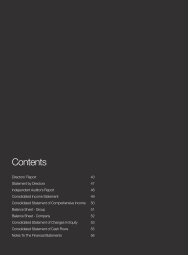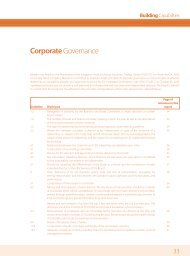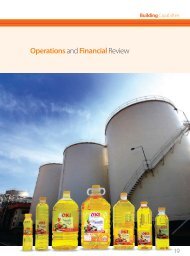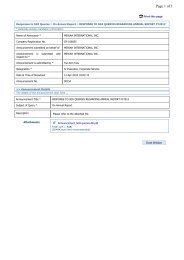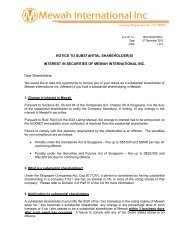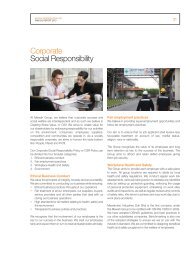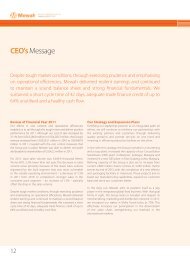FINANCIAL STATEMENTS - Mewah Group
FINANCIAL STATEMENTS - Mewah Group
FINANCIAL STATEMENTS - Mewah Group
Create successful ePaper yourself
Turn your PDF publications into a flip-book with our unique Google optimized e-Paper software.
MEWAH INTERNATIONAL INC.NOTES TOTHE <strong>FINANCIAL</strong> <strong>STATEMENTS</strong>For the financial year ended 31 December 20122. SIGNIFICANT ACCOUNTING POLICIES (CONTINUED)2.7 Impairment of non-financial assets(a) GoodwillGoodwill recognised separately as an intangible asset is tested for impairment annually and whenever there is indication thatthe goodwill may be impaired.For the purpose of impairment testing of goodwill, goodwill is allocated to each of the <strong>Group</strong>’s cash-generating-units (“CGU”)expected to benefit from synergies arising from the business combination.An impairment loss is recognised when the carrying amount of a CGU, including the goodwill, exceeds the recoverable amountof the CGU. The recoverable amount of a CGU is the higher of the CGU’s fair value less cost to sell and value-in-use.The total impairment loss of a CGU is allocated first to reduce the carrying amount of goodwill allocated to the CGU and thento the other assets of the CGU pro-rata on the basis of the carrying amount of each asset in the CGU.An impairment loss on goodwill is recognised as an expense and is not reversed in a subsequent period.(b) Property, plant and equipmentInvestments in subsidiaries and associated companiesProperty, plant and equipment and investments in subsidiaries and associated companies are tested for impairment wheneverthere is any objective evidence or indication that these assets may be impaired.For the purpose of impairment testing, the recoverable amount (i.e. the higher of the fair value less cost to sell and the valuein-use)is determined on an individual asset basis unless the asset does not generate cash inflows that are largely independentof those from other assets. If this is the case, the recoverable amount is determined for the CGU to which the asset belongs.If the recoverable amount of the asset (or CGU) is estimated to be less than its carrying amount, the carrying amount of theasset (or CGU) is reduced to its recoverable amount.The difference between the carrying amount and recoverable amount is recognised as an impairment loss in profit or loss,unless the asset is carried at revalued amount, in which case, such impairment loss is treated as a revaluation decrease. Pleaserefer to Note 2.4 for the treatment of a revaluation decrease in property, plant and equipment.An impairment loss for an asset other than goodwill is reversed only if, there has been a change in the estimates used to determinethe asset’s recoverable amount since the last impairment loss was recognised. The carrying amount of this asset is increased to itsrevised recoverable amount, provided that this amount does not exceed the carrying amount that would have been determined(net of any accumulated amortisation or depreciation) had no impairment loss been recognised for the asset in prior years.A reversal of impairment loss for an asset other than goodwill is recognised in profit or loss, unless the asset is carried at revaluedamount, in which case, such reversal is treated as a revaluation increase. However, to the extent that an impairment loss onthe same revalued asset was previously recognised as an expense, a reversal of that impairment is also credited to profit or loss.56



